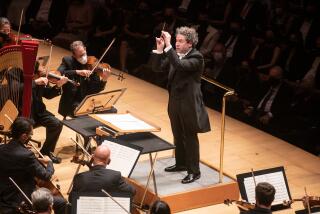Review: Michael Tilson Thomas leads L.A. Phil in Mahler at the Bowl
The first night of the Los Angeles Philharmonic’s summer season is no longer treated as Opening Night at the Hollywood Bowl, now that the Hall of Fame awards concert a couple of weeks earlier draws the fanciest picnics. That June concert was also the unveiling of the Bowl’s updated audio and visual setup.
But the L.A. Phil still tries to start off summer with something special. Tuesday night was more special than usual.
San Francisco Symphony music director and native Angeleno Michael Tilson Thomas, once a Bowl regular but last seen in the amphitheater in 2007, made a rare appearance (only his second since 1985). He conducted Mahler’s monumental, angst-overcoming, nearly 90-minute Second Symphony (“Resurrection”). There was no opening work Tuesday to allow a crowd to settle in and pour another glass of wine on a perfect summer evening, no intermission and no silliness.
FULL COVERAGE: 2013 Spring arts preview
The new sound system proved a major musical improvement. The blazingly bright, crystal-clear, $3-million LED video screens are, on the other hand, a blight.
But let’s stick for a minute with the good news, namely Mahler’s message persuasively delivered. The Second is a young composer’s attempt to find meaning in life and to give grandiose new life to the symphony. Mahler was 28 when he began the work in 1888. In it he hoped to find an apparition beyond death that makes suffering worthwhile. He was a Jew who had converted to Catholicism on what was probably a more Buddhist mission than a Christian one.
In the first movement, funereal terrors contrast with the most heavenly of visions. Elaborate song and dance follow. In the short fourth movement, the creamily exquisite mezzo-soprano Sasha Cooke sings of mortal anguish and heaven’s calling. In the long Finale, a cry from the wilderness is answered as terror turns into love’s overwhelming triumph. The brass blare. The Los Angeles Master Chorale insists that we die to live again. Cooke and the dazzling soprano Kiera Duffy offer skyward liftoff.
Such “Resurrection” is a Tilson Thomas specialty. He can get carried away, and it would not be inaccurate to accuse him of self-indulgence here and there in this symphony. When Mahler asks for a modest change of tempo, Tilson Thomas might immodestly slow down a lyrical passage to the extreme. But he can also be profoundly probing in doing so, as if looking inside every measure for what lies beneath.
PHOTOS: Arts and culture in pictures by The Times
At the other extreme on Tuesday, Tilson Thomas produced instances of immense sweep. He inspired exceptionally fine playing. And he encouraged richly expressive solo playing throughout the band. An orchestra is no democracy and this conductor is as autocratic as the next, but Tilson Thomas did, in fact, manage to nevertheless give the impression that Mahler’s suffering is our individual suffering and that Mahler’s ecstasy is shareable.
Tilson Thomas couldn’t have accomplished this without the help of the much needed new sound system. The Bowl is a vast venue; after one concert I can only report from my seat in the boxes. The bass is somewhat shy, and the midrange lacks strong presence.
But instruments sound like instruments, and that wasn’t the case before. The loudspeakers don’t attempt to hit you over the head but draw you in. Tilson Thomas refused to compensate for the outdoors. He allowed quiet passages to be very quiet. I sensed an audience listening intently, which is another thing that isn’t commonly the case at the Bowl.
And yet all these sonic advances were maddeningly downgraded by the upgraded video. The screens are so bright that they look like TV sets artificially enhanced in a showroom to catch your eye in hopes you’ll take one home. The high-definition clarity is a more startling distraction than what we are used to from the previous medium-definition screens. The colors are not the ones one sees on stage.
Eyes and ears are asked to compete, and the extreme luminosity completely changes a listener’s experience. When the video cameras cut suddenly to a sea of orchestra members in brilliant white, it makes such a violent visual effect that it serves as an added accent. When that happens off the beat, the result is more like a visual syncopation. Neither Mahler nor Tilson Thomas have final say on how the score is presented.
There was as bad helicopter intrusion during the Finale, just as the orchestra quieted down to prepare for what Mahler described as a solitary bird surveying the scene of destruction. But the video is as destructive as a perpetual helicopter.
“What you have conquered / Will carry you to God!” That is how the “Resurrection” ends. It was a glorious moment Tuesday, and a call to action. Conquer the monitors. Or at the very least, turn down, way down, the brightness.
Los Angeles Philharmonic
With: Michael Tilson Thomas, conductor, and Gil Shaham, violin
Where: Hollywood Bowl, Los Angeles
When: 8 p.m. Thursday
Tickets: $11.50-$114.50
Info: (323) 850-2000 or https://www.hollywoodbowl.com
More to Read
The biggest entertainment stories
Get our big stories about Hollywood, film, television, music, arts, culture and more right in your inbox as soon as they publish.
You may occasionally receive promotional content from the Los Angeles Times.







